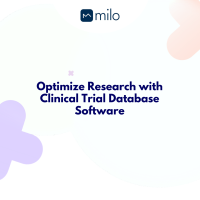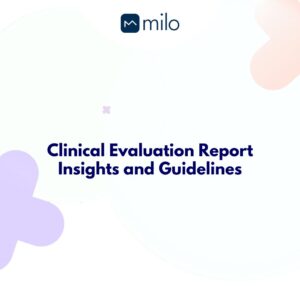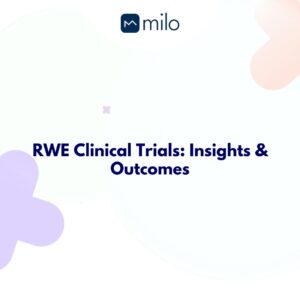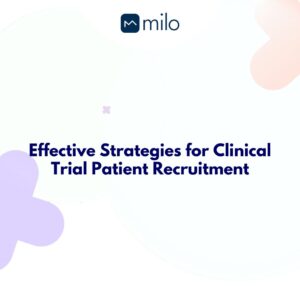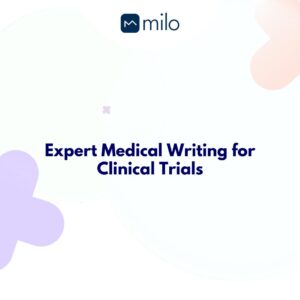MILO is a top digital platform that specializes in decentralized clinical trials. It provides an all-inclusive clinical trial database software. This software aims to improve the research process. Our wide array of services includes ePRO, eConsent, EDC, eCRF, eCOA, and RWE. These services work together to boost the effectiveness of clinical studies.
By using our software, data management in trials is revolutionized. This ensures data is more accurate, making work flows better and keeping patients more involved in trials. Our trial management solution is a trusted tool for managing research data. It combines the newest technology in clinical research.
Key Takeaways
- MILO provides a decentralized clinical trial platform designed to optimize research processes.
- Our software suite includes key components like ePRO, eConsent, EDC, eCRF, eCOA, and RWE.
- Implementation of our clinical trial database software enhances data accuracy and workflow efficiency.
- The platform focuses on improving patient engagement throughout the trial process.
- Our trial management solution is a dependable research data management platform that merges cutting-edge clinical research technology.
The Importance of Efficient Clinical Research Management
In life sciences, managing clinical research well is very important. It affects how quickly new treatments reach patients and the quality of data collected. An effective clinical study management system, like our electronic data capture software, is key. It helps researchers make their work easier.
Our clinical study management system follows industry rules and can change as clinical trials do. This flexibility helps keep data correct and work flowing well. This leads to more trustworthy and quicker results for everyone.
By using electronic data capture software, researchers can handle lots of data easily. This speeds up how fast new treatments get to the market. It also makes the data better and more reliable. So, patient care and treatment options improve faster, meeting the high standards of life sciences.
A good clinical study management system works with other systems to manage data well. Electronic data capture software cuts down on mistakes from entering data by hand. It also helps with following rules and gives updates right away. This lets researchers focus on what’s important – making medical care and knowledge better.
Therefore, choosing a great clinical study management system is more than just improving operations. It’s a key strategy to make clinical research work better and more successful.
Benefits of Using Clinical Trial Database Software
Today’s clinical research moves fast. Effective clinical trial database software is key. It boosts trials’ effects. It also makes research smoother.
Enhanced Data Accuracy
Data accuracy is crucial in trials. Study database software makes data reliable. It prevents errors. This improves data’s trustworthiness and quality.
Streamlined Workflow
Clinical trials’ workflows can be complex. Our trial data management system simplifies operations. It uses digital checklists and more. This keeps everyone focused and efficient.
Improved Patient Enrollment
Finding patients for trials is tough. Our study database software helps get patients faster. It also keeps them engaged. This leads to better participation rates.
| Benefits | Description | Outcome |
|---|---|---|
| Data Accuracy | Trustworthy source of trial data, minimizing errors | Increased data fidelity |
| Workflow Efficiency | Features like digital checklists and synchronized calendars | Smoother daily operations |
| Patient Enrollment | Innovative techniques for recruitment and retention | Higher participation rates |
Key Features of a Clinical Trial Database Software
A top-quality clinical trial database software comes with features that make trial management better. Digital patient databases help keep and find participant info quickly. This makes trials run smoother. Automated gathering of data cuts down on mistakes from manual entry and speeds up data analysis.
One key feature is the ability to analyze data in real time. This lets researchers process large amounts of data fast. It helps them make decisions quickly. Real-time insights are also great for spotting and fixing problems early.
The platform uses tools like eCOA and ePRO for better data quality. These tools collect patient reports and clinical results electronically. They make data management more complete by using real-time patient feedback. This improves data accuracy.
| Feature | Benefit | Example |
|---|---|---|
| Digital Patient Database | Streamlines participant information management | Easy access to patient histories |
| Automated Data Capture | Reduces manual errors | Accelerated data entry and analysis |
| Real-Time Data Analysis | Rapid decision-making | Timely identification of trial issues |
| eCOA Integration | Enhanced clinical outcomes assessment | Seamless patient feedback collection |
| ePRO Tools | Improved patient-reported outcomes | Real-time patient feedback |
These features are vital for a great clinical trial data management system, ready for different kinds of studies. With MILO’s platform, sites can adjust features to fit their trial’s needs. This leads to better efficiency and data quality.
How Clinical Trial Database Software Optimizes Workflows
Our clinical trial database software is great for making workflows better. It boosts efficiency and improves how clinical trials are managed. It does this by having features that make processes smoother at every level.
Digital Patient Database
The heart of our platform is the digital patient database. It uses the latest tech to keep patient info together in one place. This makes it easy to access and update. Such a system keeps data accurate and the same across all trial stages. This provides a strong base for making smart choices.
Automated Recruitment Tracking
With our automated recruitment tracking, signing up patients is simpler. It helps quickly contact potential participants and handle where they come from. This makes enrolling faster. It also makes the recruitment plan better, helping trials go smoothly.
Synchronized Team Calendars
Working together is easier with synchronized team calendars. This feature keeps scheduling issues away and helps team members coordinate better. By using these calendars in our software, we make sure everyone communicates well. This ensures all team actions are in sync, making workflows better.
| Feature | Description | Benefits |
|---|---|---|
| Digital Patient Database | Centralizes and updates patient information | Ensures data accuracy and accessibility |
| Automated Recruitment Tracking | Enables quick follow-ups and referral management | Speeds up patient enrollment and improves recruitment strategy |
| Synchronized Team Calendars | Prevents scheduling conflicts | Enhances team collaboration and aligns activities |
Choosing the Right Clinical Trial Database Software
Finding the best clinical trial database software is key for efficiency in trials. It’s important to look for features like integration with current systems, ease of use, scalable capacity, and meeting legal standards. The support from the software provider is also crucial.
When picking the software, we need to see how it fits our research technology needs. It should be easy for staff to use to avoid long training times. The software must be able to handle more data as our trials get bigger. Making sure it follows legal rules ensures our data is both correct and trustworthy.
| Feature | Importance | Impact |
|---|---|---|
| Integration with Existing Systems | High | Ensures seamless data flow |
| User-Friendliness | High | Reduces training time |
| Scalability | Medium | Accommodates trial growth |
| Regulatory Compliance | High | Maintains data integrity |
| Support from Technology Partner | Essential | Provides ongoing assistance |
By paying attention to these important aspects, we can pick a clinical trial database software. This choice will improve our research technology and trial data management. This is a big part of making our clinical research successful.
Conclusion
Effective clinical trial database software is key for better research data management. Platforms like MILO streamline clinical trial processes. They offer tools for real-time data and analytics, improving research technology.
In a post-COVID world, embracing innovative solutions is crucial for clinical trials. These technologies help optimize workflows, improve data accuracy, and boost patient involvement. All of these are vital for fast-tracking new treatments to patients.
By using advanced clinical trial database software, we’re not only improving data management. We’re also creating new standards for conducting clinical trials. Our future in clinical research relies on embracing these tech advancements. This will help bring treatments to patients quicker and more reliably. Our dedication to innovation aids researchers, patients, and the healthcare community at large.
FAQ
What is clinical trial database software?
Clinical trial database software helps manage and store trial data. It captures, stores, analyzes, and reports data accurately. This ensures the trials follow industry rules.
How does a clinical study management system improve research efficiency?
A clinical study system makes research more efficient. It streamlines data collection, patient recruitment, and compliance. Centralized data access improves collaboration and speeds up decisions.
What are the key features of a robust clinical trial database software?
Important features include digital patient records and automatic data capture. Real-time analysis and integration with research tech are also key. These help manage large data amounts and improve workflows.
How does electronic data capture software help in clinical trials?
Electronic data software ensures real-time data input and checks. This reduces mistakes, secures data accuracy, and speeds up analysis. It helps trials meet regulatory standards.
What benefits can we expect from using trial management solutions?
Trial management solutions increase data accuracy and make workflows smoother. They boost patient sign-up and quicken study times. They ensure better coordination and use of resources.
How does a trial data management system improve patient enrollment?
A data management system boosts patient enrollment with automated tracking and checklists. It helps quickly follow up on leads and manage referrals. This increases participation rates.
Why is it important to have a synchronized team calendar in clinical research?
A synchronized calendar avoids schedule issues, ensures tasks are done on time, and improves team work. It boosts efficiency and coordination in trials.
What should we consider when choosing clinical trial database software?
Choose software considering integration with current systems, ease of use, growth potential, rule adherence, and support from the provider. These affect research success and efficiency.
How does MILO’s clinical trial database software support workflow optimization?
MILO’s software boosts workflow through digital patient records, automated tracking, and team calendars. These simplify tasks, foster teamwork, and streamline operations.

